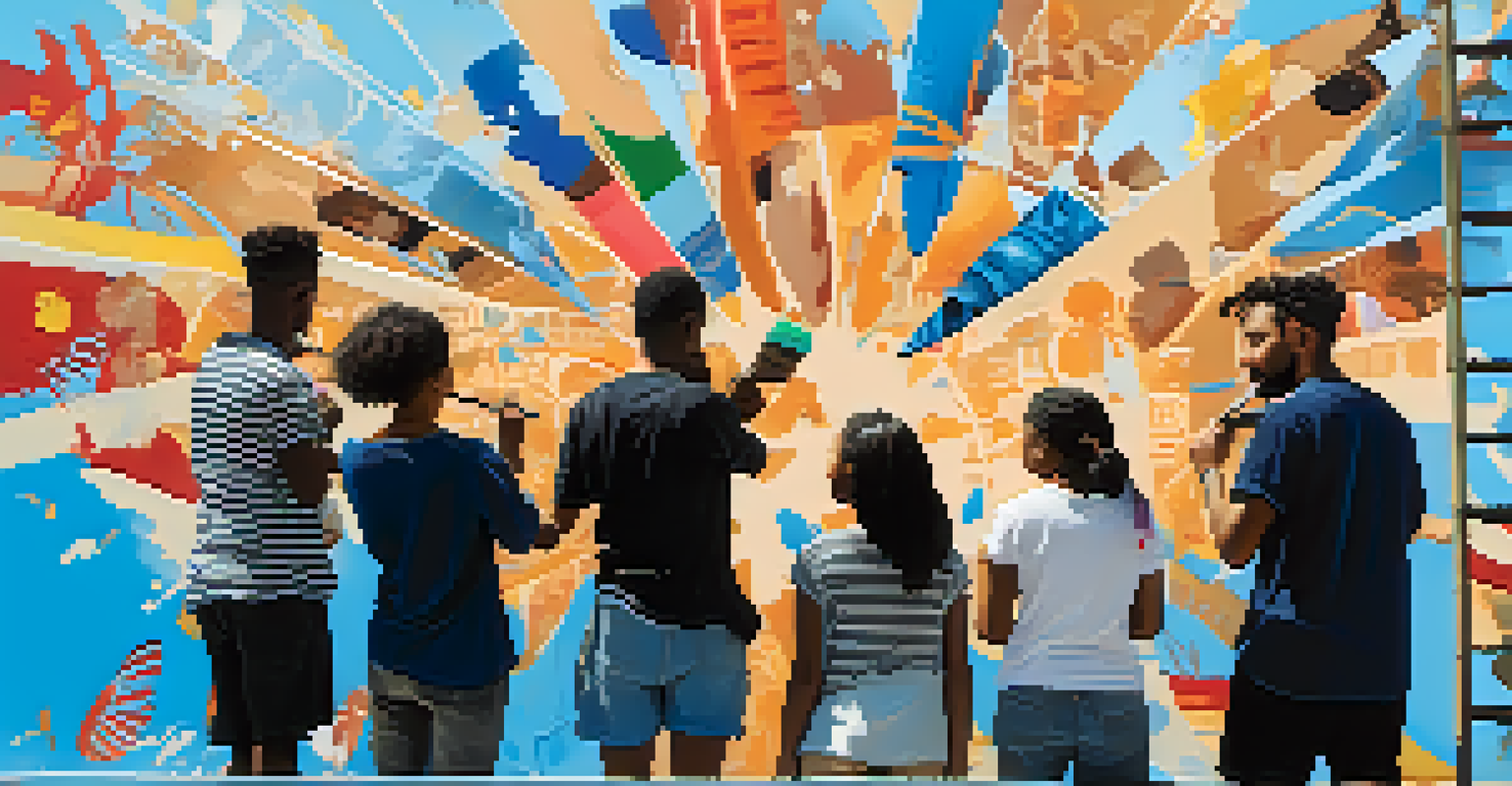Cultural Programs that Promote Youth Identity and Expression

Understanding Youth Identity in a Cultural Context
Youth identity is shaped by various factors, including culture, community, and personal experiences. As young people navigate their formative years, they seek to understand who they are in relation to the world around them. Cultural programs play a crucial role in this exploration, providing a space for self-discovery and expression.
Identity is not given, it is created and shaped by our experiences and interactions with the world.
These programs encourage youth to engage with their cultural heritage, allowing them to connect with their roots and celebrate their uniqueness. Through activities like storytelling, dance, and art, participants can express their thoughts and feelings, fostering a deeper understanding of their identities. This sense of belonging is vital for their emotional and social development.
Moreover, cultural programs often bring together diverse groups of young people, promoting intercultural dialogue and understanding. By sharing their stories and experiences, youth can find common ground, appreciate differences, and build relationships that transcend cultural barriers.
The Role of Arts in Youth Expression and Identity Formation
The arts, including music, dance, theater, and visual arts, serve as powerful tools for youth expression. They provide a creative outlet for young people to convey their thoughts, feelings, and experiences in ways that words alone may not capture. Through artistic endeavors, youth can explore their identities and communicate their unique perspectives.

For instance, a community mural project allows young artists to visually depict their stories and aspirations. Such collaborative efforts not only beautify public spaces but also empower youth to take ownership of their narratives. This sense of agency is crucial for building confidence and self-esteem.
Cultural Programs Shape Identity
Cultural programs provide youth with opportunities for self-discovery and help them connect with their heritage.
Furthermore, engaging in the arts can help youth develop essential life skills, such as teamwork, problem-solving, and critical thinking. These skills are transferable to various aspects of life, from academics to future careers, enhancing their overall growth and development.
Cultural Festivals as Platforms for Youth Engagement
Cultural festivals are vibrant celebrations that bring communities together, showcasing the richness of diverse traditions. These events often provide young people with opportunities to perform, share their talents, and express their identities. Participating in such festivals fosters a sense of pride in their culture and encourages them to explore their heritage.
Art is the most beautiful of all lies, and the most truthful of all lies, for it reveals the essence of humanity.
For example, youth-led performances at festivals can serve as a platform for addressing social issues, allowing young voices to be heard. This not only empowers participants but also educates the broader community about the challenges and triumphs faced by youth. The visibility gained through such platforms can have a lasting impact on their self-perception.
Additionally, festivals often incorporate workshops and discussions that encourage young people to engage in dialogue about identity and expression. These interactions can spark ideas, inspire creativity, and motivate youth to take an active role in shaping their cultural narratives.
Digital Media: A Modern Avenue for Youth Expression
In today's digital age, social media and online platforms have revolutionized how youth express themselves and connect with others. Young people can share their stories, art, and cultural experiences with a global audience, breaking down geographical barriers. This accessibility empowers youth to find their voices and engage in meaningful discussions about identity.
For instance, platforms like Instagram and TikTok have become popular avenues for youth to showcase their creativity and cultural heritage. By participating in trends that celebrate diversity, young creators can foster a sense of belonging and encourage others to embrace their identities. This virtual community can be incredibly supportive and affirming.
Arts Foster Youth Expression
The arts serve as powerful tools for youth to express their identities and communicate their unique perspectives.
However, it's essential to navigate this digital space mindfully, as online interactions can also pose challenges. Encouraging critical thinking about media consumption and self-presentation can help youth build resilience and a healthy sense of identity in the digital realm.
Community-Based Programs Supporting Youth Identity Development
Community-based cultural programs are instrumental in fostering a sense of belonging among youth. These initiatives often focus on local traditions, languages, and practices, providing young people with an opportunity to connect with their cultural roots. By participating in community events, youth can build relationships that strengthen their identities.
Programs such as mentorship initiatives, cultural workshops, and storytelling circles create safe spaces for youth to share their experiences and learn from one another. These interactions can help dismantle stereotypes and promote understanding, allowing youth to appreciate the richness of diversity within their own neighborhoods.
Moreover, engaging in community programs encourages youth to take pride in their heritage and develop leadership skills. By taking part in organizing events or leading discussions, they gain valuable experiences that contribute to their personal growth and identity formation.
The Impact of Cultural Exchange Programs on Youth Identity
Cultural exchange programs offer young people the opportunity to immerse themselves in different cultures, often leading to profound personal growth. By interacting with peers from diverse backgrounds, youth can gain new perspectives and broaden their understanding of identity. These experiences can challenge preconceived notions and foster empathy.
For example, participating in an exchange program may allow youth to explore cultural practices, languages, and traditions that differ from their own. This exposure not only enriches their knowledge but also encourages them to reflect on their identities in a global context. Such experiences can be transformative, instilling a sense of global citizenship.
Digital Media Empowers Youth Voices
Social media platforms allow youth to share their stories and experiences globally, enhancing their sense of belonging.
Additionally, cultural exchange programs often emphasize the importance of collaboration and communication. By working together on projects or participating in cultural activities, youth develop essential interpersonal skills that enhance their capacity for self-expression and identity development.
How Schools Can Foster Youth Identity Through Cultural Programs
Schools play a crucial role in shaping youth identity, and integrating cultural programs into the curriculum can be incredibly beneficial. By incorporating diverse cultural perspectives into lessons, educators can help students understand and appreciate the richness of different identities. This approach fosters a sense of belonging and encourages respectful dialogue among peers.
Extracurricular activities, such as cultural clubs and art programs, provide additional opportunities for students to explore their identities outside the classroom. These initiatives empower youth to express themselves creatively and engage with their cultural heritage, ultimately enhancing their self-esteem.

Furthermore, involving parents and community members in school-based cultural programs can strengthen connections between home and school. This collaboration not only enriches the learning environment but also reinforces the value of cultural diversity in shaping youth identity.